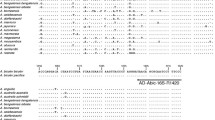Abstract
Substitution of a high-value fish species and their products with a low-value species has recently emerged as a problem in the fishery industry, and the need for development of analysis tools for the identification of different species has been discussed globally. The genus Sebastes is the most species-rich of the family Scorpaenidae, and many of the species of Sebastes are commercially and ecologically important, particularly in the North Pacific. They exhibit high morphological similarity among species, and are difficult to distinguish visually. In this study, we selected nine common Sebastes species (S. pachycephalus, S. fasciatus, S. inermis, S. oblongus, S. owstoni, S. hubbsi, S. schlegeli, S. vulpes, and S. thompsoni) for development of a differentiation assay. Fluorescence melting curve analysis (FMCA) was used to distinguish the nine species of Sebastes with single locked nucleic acids (LNA). Dual-labeled probes were designed from the mitochondrial cytochrome c oxidase subunit I gene to detect each species and hybridize with the target sequence. In addition, we successfully multiplex analyzed three species of Sebastes using the fluorescent dyes FAM, HEX, and Cy5. The LNA-based FMCA method we developed is a powerful tool for the identification of nine different species of Sebastes.
Similar content being viewed by others
References
Nelson, J.S., Grande, T.C. & Wilson, M.V. Fishes of the world. John Wiley & Sons (2016).
Love, M.S., Yoklavich, M. & Thorsteinson, L.K. The rockfishes of the northeast Pacific. Univ. of California Press (2002).
Kai, Y., Nakayama, K. & Nakabo, T. Molecular phylogenetic perspective on speciation in the genus Sebastes (Scorpaenidae) from the Northwest Pacific and the position of Sebastes within the subfamily Sebastinae. Ichthyological Res. 50, 239–244 (2003).
Hyde, J.R. & Vetter, R.D. The origin, evolution, and diversification of rockfishes of the genus Sebastes (Cuvier). Mol. Phyl. Evol. 44, 790–811 (2007).
Kai, Y. & Nakabo, T. Morphological differences among three color morphotypes of Sebastes inermis (Scorpaenidae). Ichthyological Res. 49, 260–266 (2002).
Kai, Y., Nakayama, K. & Nakabo, T. Genetic differences among three colour morphotypes of the black rockfish, Sebastes inermis, inferred from mtDNA and AFLP analyses. Mol. Ecol. 11, 2591–2598 (2002).
Civera, T. Species identification and safety of fish products. Vet. Res. Commun. 27, 481–489 (2003).
Armstrong, S.G., Leach, D.N. & Wyllie, S.G. The use of HPLC protein profiles in fish species identification. Food Chem. 44, 147–155 (1992).
Asensio, L., González, I., García, T. & Martín, R. Determination of food authenticity by enzyme-linked immunosorbent assay (ELISA). Food Control 19, 1–8 (2008).
Rasmussen, R.S. & Morrissey, M.T. DNA-based methods for the identification of commercial fish and seafood species. Compr. Rev. Food. Sci. F. 7, 280–295 (2008).
Gil, L.A. PCR-based method for fish and fishery products authentication. Trends Food Sci. Tech. 18, 558–566 (2007).
Ahn, J.J. et al. Differentiation of Scomber japonicus from Scomber scombrus by using a single locked nucleic acid probe. Mitochondr. DNA. 28, 379–382 (2017).
Gunson, R.N., Bennett, S., Maclean, A. & Carman, W.F. Using multiplex real time PCR in order to streamline a routine diagnostic service. J. Clin. Virol. 43, 372–375 (2008).
Johnson, M.P., Haupt, L.M. & Griffiths, L.R. Locked nucleic acid (LNA) single nucleotide polymorphism (SNP) genotype analysis and validation using real time PCR. Nucleic Acids Res. 32, e55–e55 (2004).
Johansson, M.K., Fidder, H., Dick, D. & Cook, R.M. Intramolecular dimers: a new strategy to fluorescence quenching in dual-labeled oligonucleotide probes. J. Am. Chem. Soc. 124, 6950–6956 (2002).
Elenitoba-Johnson, K.S., Bohling, S.D., Wittwer, C.T. & King, T.C. Multiplex PCR by multicolor fluorimetry and fluorescence melting curve analysis. Nat. Med. 7, 249–253 (2001).
Ahn, J.J. et al. Probe-based fluorescence melting curve analysis for differentiating Larimichthys polyactis and Larimichthys crocea. Food Anal. Method. 9, 2036–2041 (2016).
Author information
Authors and Affiliations
Corresponding author
Electronic supplementary material
Rights and permissions
About this article
Cite this article
Noh, E.S., Kim, Y.S., Kim, E.M. et al. Method for the differentiation of nine species of Sebastes with fluorescence melting curve analysis and dual-labeled probes. BioChip J 11, 206–212 (2017). https://doi.org/10.1007/s13206-017-1402-x
Received:
Accepted:
Published:
Issue Date:
DOI: https://doi.org/10.1007/s13206-017-1402-x




